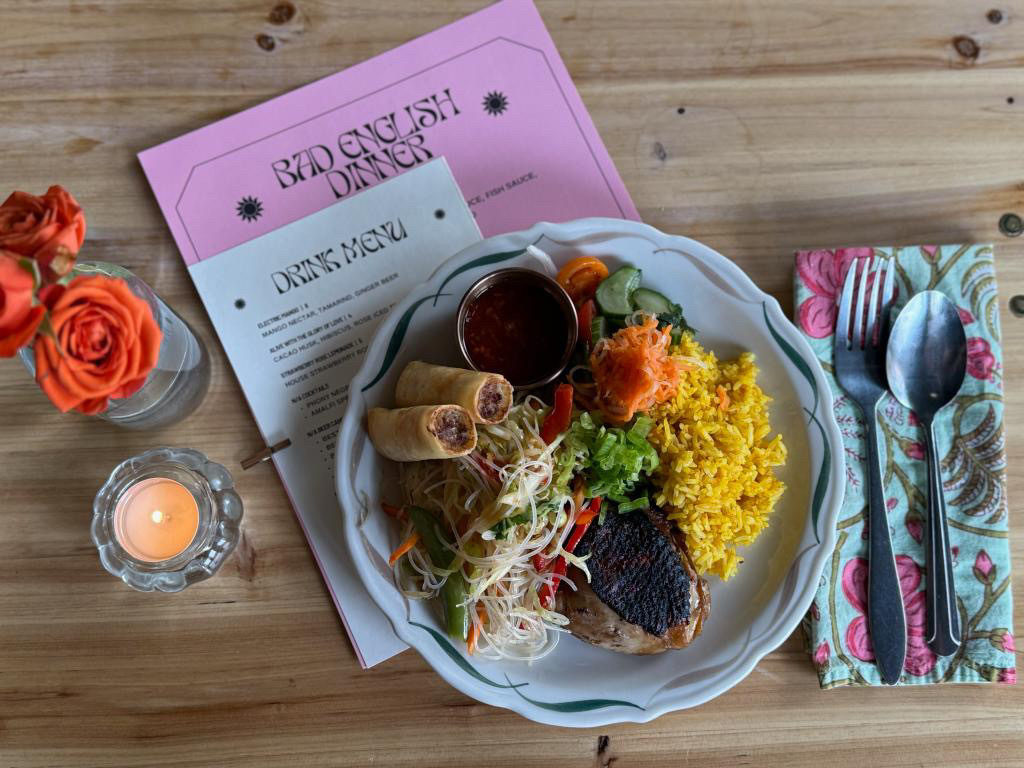Juneil Cabreza
Bad English chef talks adobo, paprika and why "more people should be using green onions."

Filipino feast from Bad English. Photo courtesy of Juneil Cabreza.
Editor: This is the second installment of a new series in which Urban Milwaukee will explore five ingredients and how to use them with Milwaukee chefs, growers and caterers.
For the first eight years of his life, Juneil Cabreza spoke only Tagalog, mastering the language along with his earliest culinary skills at his mother’s side in the kitchen.
“I got to learn how to cook from her from an early age,” he said. “Everything was always homemade. Nothing was store bought.”
As Cabreza matured, family trips to the Filipino grocery store gave way to to culinary school classes and, eventually, stints at fine dining restaurants across the country.
Meanwhile, Cabreza began learning English as a second language—a process that came with its own challenges. “It was just vernacularly bad,” he recalled. “When you come to America, when you immigrate, you have bad English.”
Undeterred, Cabreza leaned into his culture—honing the comforting dishes, familiar flavors and sense of hospitality that characterize Filipino cuisine. Then he bought a food truck, called it Bad English and let his talent do the talking.
Though he now speaks with fluency, Cabreza has come to rely on a more universal language: flavor. And he’s found his niche in a “no muss, no fuss” approach to hospitality: big portions, good value and an acute dedication to generosity, which he attributes to his heritage.
“If you ever go to a Filipino gathering, there’s literally a cardboard box full of Tupperware and random to-go containers, and you are forced to take something home because they make so much food,” Cabreza said. “The whole culture is centered on generosity and bringing enough to feed everybody—making sure everyone is nourished.”
That philosophy carries over into Cabreza’s staple ingredients: dark soy sauce, vinegar, baking soda, green onions and smoked paprika.
“Those five are always in my house, always in the restaurant, and I will always go to them, because they always do something to help any dish out,” Cabreza said.
But more than just flavor enhancers, most of Cabreza’s chosen ingredients are also multi-purpose, doubling as cleaning agents, tenderizers and more.
Here’s a closer look at Cabreza’s staples, and his suggestions for how to use them at home.
Baking Soda
Don’t let the name fool you. Though best known as a raising agent for baked goods, sodium bicarbonate is a powerhouse in the kitchen.
Cabreza’s favorite application? Meat tenderizer.
“Any type of cut you have, slice it super thin, add a teaspoon or two of baking soda and rub it in with all your other flavorings—spices, salt, pepper,” he said. “Let it sit for 15 minutes in the fridge and you’ll see it gets just super tender.”
The technique, a take on Chinese velveting, relies on baking soda’s alkaline pH to weaken the meat’s protein bonds before cooking. It works particularly well for stir-fried meats, Cabreza added.
Smoked Paprika
Most home cooks don’t have a smoker in their kitchen, but nearly everyone has a jar of smoked paprika. In special cases, the latter can yield comparable results, according to Cabreza.
“Say you just want a bit of smoke essence, just throwing a little in your spice mix or adding it on top, you already have something more aromatic, more flavorful,” he said.
Though great for vegetarian dishes or at-home barbecue chips, Cabreza’s most notable use for smoked paprika is in his copycat version of Dave’s Hot Chicken spice blend, an endeavor he’s keeping under wraps—for now.
Dark Soy Sauce
Unlike its Chinese counterpart, Filipino soy sauce isn’t fermented.
“It’s essentially dyed salt water,” Cabreza said of the condiment, am essential in dips, condiments and—perhaps most importantly—adobo, the marinated chicken dish largely recognized as the Philippines’ national food.
“Filipino adobo is just soy sauce, vinegar, peppercorns, bay leaf and garlic—plus a bit of sugar or garlic, depending on the family that you live with,” Cabreza said. Like Sunday sauce among Italians, ingredients and techniques are tailored to the cook, often handed down through generations.
Dark soy sauce imparts a flavor-balancing dose of umami and a hint of complexity in most any dish. It also brings a deep, rich color to sauces, stir fries and stews, enhancing visual appeal.
Vinegar
Vinegar, another essential ingredient in adobo, is Cabreza’s secret weapon for a wide variety of kitchen tasks—its “multi-purpose” value stretching far beyond simple marinades.
“Just a little bit with salt is a flavor enhancer,” Cabreza said. “I actually learned that from fine dining.”
And not just for chips; the trick brightens up cooked vegetables, salads and even pasta sauce.
“I always recommend sherry, because you only need a little bit and it lasts for a long time,” Cabreza added. “Apple cider vinegar: even better, because you can end up making a vinaigrette with that.”
It’s also key for quick-pickles—great to cut through rich, saucy Filipino dishes—and doubles as a household cleaner in a pinch. “I try to make sure whatever I use can be useful in many different ways,” Cabreza said.
Green Onions
“More people should be using green onions,” Cabreza said, praising the humble allium for its dual-purpose components and regenerative qualities.
The tender white stalks are milder than onions but hold up well when cooked, while the bright green tops serve as an attractive and flavorful garnish.
“A lot of Italian restaurants use green onions like crazy,” Cabreza added.
And he would know—the chef previously operated the East Side’s L’Incontro, blending Italian cuisine with global influences.
Another bonus: the onions can regrow their green tops when placed in water. Just be careful which ones you pick. “If you have a bitter onion, it will grow back even more bitter,” Cabreza said.
Bad English, which previously operated out of L’Incontro, now exists as a pop-up and catering company. Cabreza holds weekly services in Shorewood at Love Cafe, owned by his partner, Kaleigh Atkinson. The cafe also hosts regular installments of Kamayan Feast, a family-style spread meant to be eaten with your hands.
If you think stories like this are important, become a member of Urban Milwaukee and help support real, independent journalism. Plus you get some cool added benefits.
Five Ingredients With a Foodie
-
Bartender James Potter
 Nov 21st, 2025 by Sophie Bolich
Nov 21st, 2025 by Sophie Bolich
-
Jenny Lee
 Sep 19th, 2025 by Sophie Bolich
Sep 19th, 2025 by Sophie Bolich
-
Ramses Alvarez
 Aug 27th, 2025 by Sophie Bolich
Aug 27th, 2025 by Sophie Bolich




















